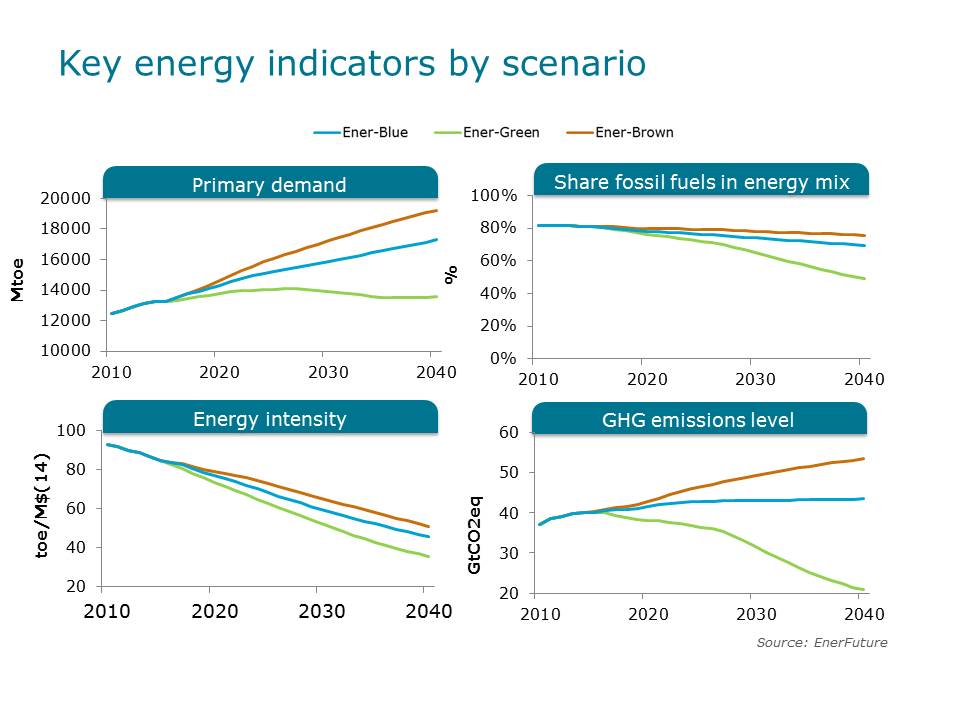Paths for the global energy landscape over the next 25 years
Overview
The energy world is in rapid evolution, driven in particular by policy developments (like the INDCs agreed at COP-21) but also economic, geopolitical, technological as well as social considerations. Enerdata regularly produces scenario based energy outlooks to analyse and forecast the supply and demand of energy commodities, energy prices, as well as the impact of climate change and energy policies on energy markets and their consequences for the energy industry. After the COP-21 in Paris, Enerdata has again done such an exercise.
The Ener-Blue scenario provides an outlook of energy systems up to 2040 based on the achievement of the 2030 targets defined in the INDCs as announced at the COP-21.
Ener-Green explores the implications of more stringent energy and climate policies to limit the global temperature increase at around 1.5-2°C by the end of the century.
Finally, Ener-Brown describes a world with abundant fossil fuel resource and durably low energy prices, affecting the entire energy system over a long period.
These different scenarios explore the consequences on energy supply and demand, energy mix, energy prices by fuel and region, as well as the implications on climate issues.

Findings
- In the Ener-Blue scenario, the future energy mix remains dominated by fossil fuels, but INDCs planned policies regarding climate mitigation, energy efficiency and renewable energy sources lead to a diversification towards other sources of energy. Among others, the EU successfully achieves its triple objective of its climate and energy package, while China and India expand their renewable capacities to achieve their renewable targets. Within this international context of climate coordinated policies, CO2 emission growth slows down. However, the efforts defined in INDCs are not ambitious enough to limit the increase of the average global temperature to 2°C in 2050, but these efforts are compatible with 3-4°C objective.
- In the Ener-Green scenario, there is a clear transition from the current energy system towards a long-term decarbonisation, with substantial efforts on energy efficiency, initiatives to phase out fossil fuel subsidies and a real emergence of renewable energy technologies. This is achieved through ambitious policies both at the national and international level and through strict carbon constraints. Deployment of low-carbon technologies plays a key role, supported by significant R&D efforts to reduce their cost and improve their performance. In the power sector, RES become the main source of electricity generation around 2040; there is a growing adaptation of cleaner coal technologies and a wide-scale of deployment of CCS. Nuclear turns to be an attractive option. Talks at the COP-21 are successful, governments commit to returning to the negotiating table and revise their emissions goal every five years. This new “green deal” leads to a reduction factor of 2 of world emissions by 2050.
- In the Ener-Brown scenario, OPEC output continues to rise to maintain its market share while the unconventional oil and gas boom in North America carries on and gets exported to other world regions (China, Argentina…). With less tensions, oil and gas prices are expected to remain weak: prices slowly recover from present collapse, but remain well below the last decades highs. Confirmed energy commitments in some regions as well as technological innovation foster a significant development of low energy intensive processes and technologies. Renewables achieve a substantial deployment but affordable fossil fuels still remain a competitive and attractive source of energy. Without a global agreement, non-coordinated policies result in soaring CO2 emissions across the world, towards +5-6°C temperature increase by the end of the century.
Conclusions
The paper will present in detail some results related to the Ener-Blue scenario (INDCs), its impacts on different energy sources and geographical regions, as well as its challenges in implementation. It will also show what additional commitments are needed to move from the Ener-Blue to the Ener-Green (2°C) scenario, and it will present the consequences of a scenario (Ener-Brown) where - due to an abundance of cheap hydrocarbon resources - these continue to be used large scale, even though in parallel important efforts are done as far as sustainable development is concerned.
 Energy and Climate Databases
Energy and Climate Databases Market Analysis
Market Analysis